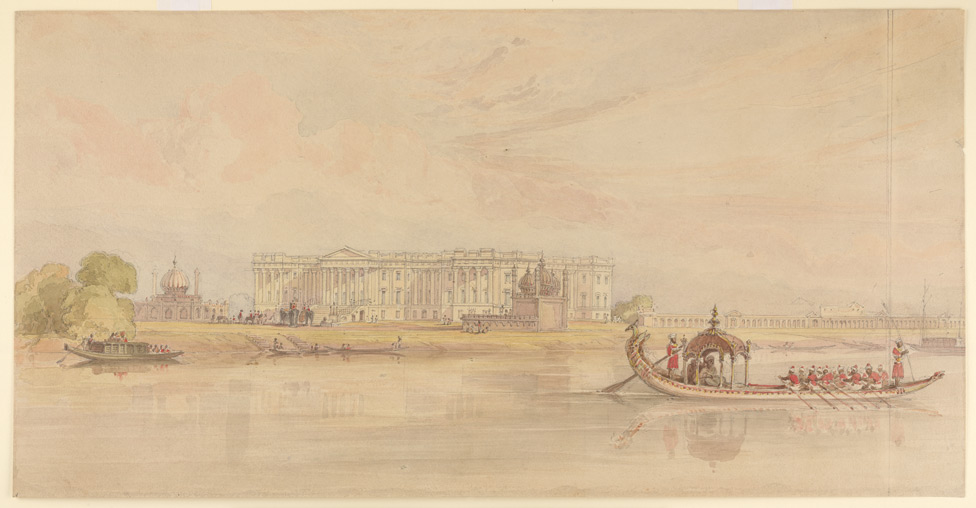
An Old painting depicting Nizamat Imambara in the Extreme Right.(Courtesy Google Image)
Dr.Mazhar Naqvi
The defeat at the battle
of Plassey has overshadowed all the good deeds of Nawab Siraj- Ud- Daula. He is
usually remembered by the terms used for him by his vanquisher Robert Clive who
portrayed him "as a monster of vice, cruelty and depravity.”
As his defeat marked the beginning of British rule in India, even Indians like
the Britons who were responsible to overthrow his legitimate regime consider
him as an arrogant, hot headed, impatient and indecisive ruler. Holding such
opinion about Siraj is a grave injustice. A careful look at his life reveals that
he was victim of betrayal and instead of indecisiveness; he should be blamed
for believing people too easily whereas as a ruler, Siraj should have not
trusted his own shadow even. Siraj did so and paid a very heavy penalty. He was
not only defeated and executed but also failed to get the place he deserves on
the pages of history. Instead of being considered as a freedom fighter, he is referred
to as a weak ruler whose lack of wisdom paved way for British empire on Indian
soil. What an irony? Tipu Sultan did exactly what Siraj did decades before him.
But Tipu is remembered with reverence and people flock at his grave near Mysore
while Siraj lies in a simple grave besides his illustrious grandfather Nawab
Alivardi Khan in Khoshbagh of Murshidabad, former capital of undivided Bengal. Perhaps
no one goes to Siraj’s grave to place even a rose bud on his death anniversary
on July 2.

Grave of Nawab Siraj- Ud -Daula
The last Nawab of independent
Bengal Mirza Muhammad Siraj- Ud-Daula however
shares one strikingly common factor with Tipu. Born to Zain ud-Din Ahmed Khan
and Amina begum, daughter of Alivardi Khan in 1733, Siraj also revered ‘Ahlebait’
like Tipu. He even surpassed Tipu in terms of exhibiting his love for Imam Hussain.
While Tipu restricted him to issuance of coins in the name of Imams and got the
books of his library stamped with the seal containing the names of holy
Panjatan, Siraj built a magnificent Imambara in Murshidabad in the most pious
manner. He bought bricks and mortar and
laid the foundation of the building with his own hands. The plot where the
Imambara was erected was dug up to a depth of 6 feet. It was refilled with soil
brought from Mecca so that Muslims unable to undertake Hajj for want
of funds could feel the experience of the holy city in Murshidabad. Besides
other materials, Siraj however placed heavy reliance on the use of wood in the
construction of wood. The structure, known as old Nizamat Imambara survived
gracefully and served as a center of Azadari even after the death of Siraj. But it caught
fire in 1842 and a party of Imambara was destroyed. A fire completely destroyed it on December
23, 1846. That unfortunate day, the ruling Nawab along had thrown a party
to celebrate the weaning ceremony of five-year-old Hassan Ali Mirza. The Imambara caught fire
at midnight due to the fireworks left off to entertain the European
guests. Nothing survived except the old Madina Mosque. The fire also gutted the relics
that were installed by Siraj at the Imambara.
A new Imambara replaced the one
erected by Siraj and destroyed by fire in a record time of 11- months. Nawab
Nazim Mansur Ali Khan ordered its construction in 1847 under the supervision of Sadiq Ali Khan at a cost of more than Rs.6
lacs. The new Imambara is 680 feet long and its central block with Madina mosque
is 300 feet long. The new structure was built some feet away from the site of
the old building in north. The Imambara today is considered to be one of the largest
in the world and stands opposite to the Hazarduari Palace on the banks of the
Bhagirathi River. It becomes the hub of mourning ceremonies after the sighting
of Muharram moon every year. (References available on request.)
No comments:
Post a Comment